I suppose this could almost be considered a sort of "part 2" of my Christmas at Greenfield Village post, though this is not about Christmas---it's about winter. I wrote of my spring, summer, and fall adventures to historic Greenfield Village over the course of 2021. However, the Village is closed during the winter months, so doing a posting for this Jack Frost time of year can be difficult. What this means is we have to modify our thoughts a bit to show the winter experience, for, since we cannot visit throughout the actual winter months of January, February, and March, I've taken the liberty of showing my recent snow photos - those taken in late November and late December 2021 - and applied them here. Between the two sets, the majority of which were taken at the 1750 Daggett House, I believe we can get a fine look and feel for a Greenfield Village winter excursion~
.............................................
John Lennon once sang:
If the rain comes
They run and hide their heads
They might as well be dead
If the rain comes
When the sun shines
They slip into the shade
And sip their lemonade
When the sun shines
Isn't that the truth? We're at a time in history where, due to the media, we fear nearly everything, including rain and snow storms. I remember being a kid and running through the rain puddles on the sidewalks and in the street. Or, at our cottage near Lake Huron, walking barefoot along the dirt roads while my toes squished in the mud, raining all the while.
I remember as a kid diving into the cold wet snow, building a snowman or a poor attempt at an igloo. Or, as a teen and adult, just enjoying a walk while flakes fell all around, maybe a biting wind that warranted a cup of hot chocolate upon returning.
Why do so many people today fear (or dislike) the weather so much?
Here in Michigan reenactments all but stop in the winter, for though people will spend a load of money to purchase their period summer garments, they refuse to even think about buying winter wear. If they do, they will rarely wear 'em. And then oftentimes during a July reenactment I'll hear, "I'm not going to the event - it's too hot."
Wow---what a way to live, eh?
Now, I'll be the first to admit I am not fond of the extreme weather on either end. But I've not let it prevent me from doing things I enjoy. I remember one 4th of July (2012) where the temps reached over 100 degrees, and there we were, enjoying the day and having a picnic at Greenfield Village all the while in our 1860s clothing. Yes, it was hot and we felt it, but we had such a good time.
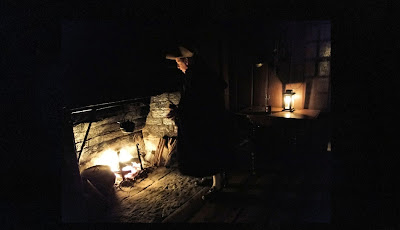 |
| Warming my toes at the Daggett hearth on a bitter 6 degree December night in 2017. |
On the other end I recall being at Greenfield Village during Holiday Nights in late December (2017, I believe), and the temperature was at a bitter 6 degrees. And there I was, in my full colonial get up, experiencing history as my ancestor's did, even including warming my toes at the hearth of the Daggett fireplace. My woolen cloak kept me nice and warm while outdoors, though I must admit everything below my knee breeches were a mite cold.
Twice in late 2021, while at Greenfield Village, we had a snowfall - once at the end of November during a daytime visit and once at the end of December (during Holiday Nights). Oh, not any sort of major storms. Just a couple inches of the white stuff fell. So myself, along with a couple of living history friends, ventured out and took advantage of the winter weather. For Holiday Nights, my wife came along, though dressed modern, and willingly snapped the majority of pictures you are about to see, most taken around the area of my favorite historical structure, the home built about 1750 by Samuel Daggett.
So we'll begin with that evening in late December:
This picture of the home of Samuel & Anna Daggett was taken on a late afternoon during a late December snowstorm in 2021.
My friend, Ian, loves to paint as a hobby. When he heard that I wanted a winter Daggett photo, look what he did for me:
 |
| A wonderful Daggett painting by Ian Kushnir. |
So...for today's posting I thought I would write it in a sort of time-travelly way.
As the story goes, a few of us, including my friends Jennifer and Amy, decided to enjoy winter weather by dressing in our colonial attire when we decided to take a walk along a forest of trees. The snow began lightly, as most storms do, until the flakes grew in size and the wind growing alongside until we were nearly blinded by white.
"Whose woods these are I think I know.
His house is in the village though.
He will not see me stopping here.
To watch his woods fill up with snow."
Robert Frost
 |
| We slipped our way up the hill toward this ancient structure. |
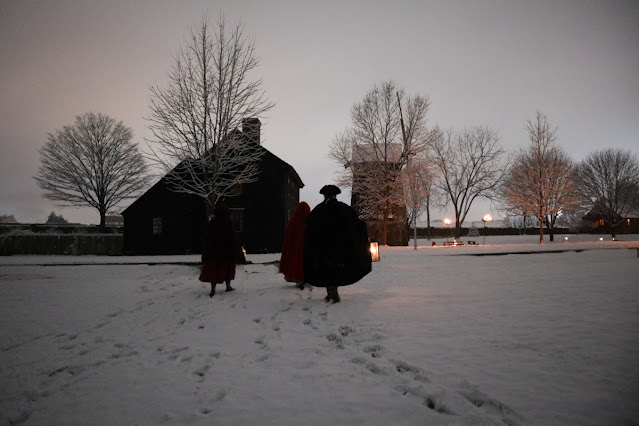 |
| We made it without falling even once. To my right you can see the fires glowing from the two cressets set a-flame. |
 |
The snow actually did come down quick and hard, easily covering the landscape in no time. |
 |
| Amy and Jennifer had recently sewn their winter cloaks, allowing them the opportunities to enjoy winter colonial excursions. I am certainly glad they did; they were good company! |
 |
| This was quite odd, to say the least, but we were thankful for her friendliness and receptive demeanor. |
 |
| And this is what we were greeted with in the great hall upon entering the front door. It was a dark world, to be sure, but the lanterns, by looks alone, gave it a warmth. |
 |
| I am but a shadow in this image...but I am there, and the warmth of the room felt good. Our hostess was very kind and welcoming to the three of us. |
 |
| There I am again, standing in the kitchen doorway looking into the great hall. |
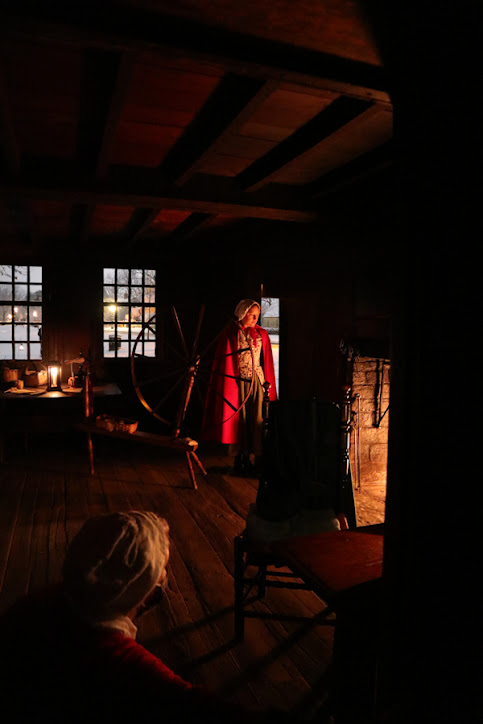 |
| And from that position I snapped this haunting image of Jennifer. Looks like our hostess on the lower left. |
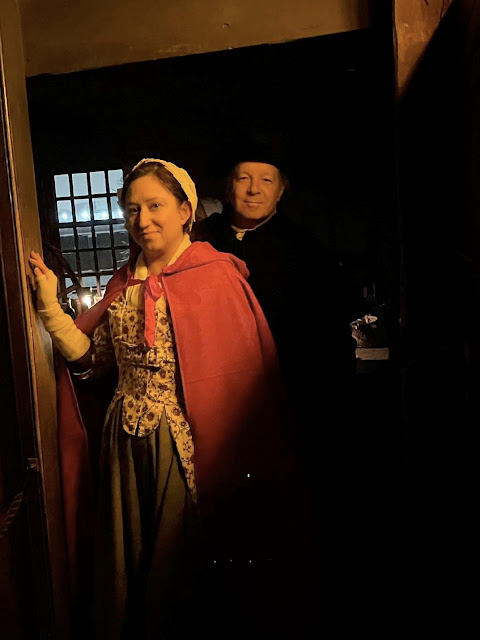 |
| Jennifer & I in the top photo - - and that's Amy in the bottom photo.  |
 |
| With us now warm and dry, and since the snowfall had ended, Jennifer, Amy, and I felt it was time to bid farewell to the Daggett household. |
So we were off and on our way.
And, just outside the Daggett house door...(let's get a history lesson on a few of the structures here):
(It is unfortunate that, aside from a recording played inside, very little is done with this historic home, which was originally built in the early 1700s. I realize the Daggett House is being utilized to show mid-1700s life, and I love that, but there is much more history to be shown, especially with the sestercentennial (250th) anniversary of our Nations birthday coming up in just over four years.)~
Next up, a house once known as "The Mansion House":
 |
John Giddings, the builder of this house, married Mehetable Gilman in the fall of 1751, and since nearly every research page that mentions this house says it was constructed in that same year, I'm going to speculate that he built it a number of months before his impending marriage with the thoughts of his new bride and the hopes for a future family in mind. Well, over a span of 18 years, John and Mehetable did had five children: Mary (1752), John (1754), Dorothy (1758), Mehetable (1764), and Deborah (1770). |
A mid-winter gathering of friends.
Perhaps they could help us find our way - - -
As we moved along the road, we came across an old cabin - -
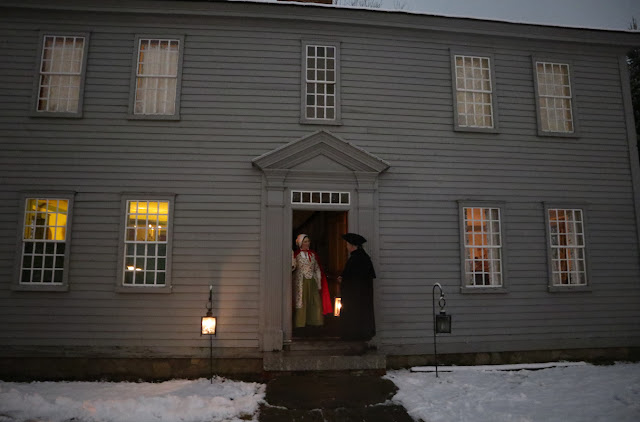 |
| I was greeted by the Giddings' maid-servant (who looked remarkably like Jennifer!). Jennifer! What are you doing answering the door? |
 |
| According to the Exeter, New Hampshire Probate Records of 1824, this building was referred to as "the mansion house." One can see just by the exterior alone that it represents a more well-to-do residence of 18th century colonial America, suitable for a man of means such as our Mr. Giddings. This beautiful structure was situated on property that also included a warehouse and mercantile shop, both of which Giddings operated, and over-looked a wharf on the Squamscott River. |
"(John Giddings) ran a small mercantile business from his wharf below on the Squamscott River. His account book, which reveals transactions primarily through barter, is in the collections of the Exeter Historical Society. Most of his goods were shipped through the West Indies, indirectly bringing textiles from Great Britain and, good lord, an amazing amount of sugar and rum.
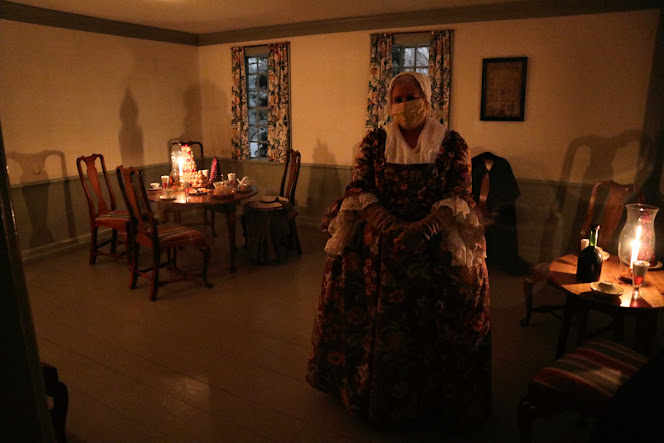 |
| As I entered the house, I found that Mehetable Giddings thought Jennifer as a maid-servant and had her answer the door when I knocked upon it. Not just ask, but demanded! |
 |
| Candle-lit period homes: to think there was no other choice but to live by natural light or a small flame when nighttime came along...as we find with power outages in modern times, that would be difficult. |
 |
| But there is a calming affect candlelight leaves upon me. |
 |
| On this mid-winter gathering night, the wealthy Mr. Giddings hired a chocolateer to treat and entertain guests. |
The following two photographs were taken a couple of years ago. I thought I would include them to add to the story:
 |
| There was a fiddler playing dance tunes - what fun it would be to join in! |
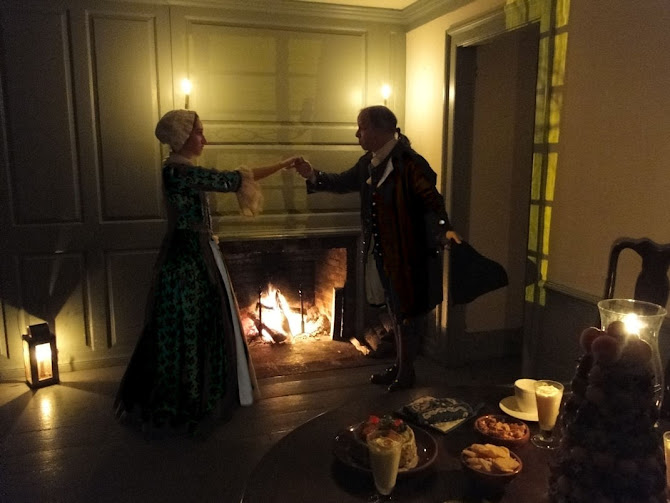 |
| I was able to dance one dance with a Giddings daughter, something she called "an allemande," before having to leave. Jennifer, Amy, and I were looked upon as rather odd for asking questions of our location, the year it was, and even due to our verbiage - the way we spoke was quite curious to our hosts. |
 |
| Amy, can you believe the woman in there thought I was a servant?? She actually put me to work!! |
As we moved along the road, we came across an old cabin - -
 |
This here is the McGuffey Cabin~ The 1780 log cabin was the birthplace of William Holmes McGuffey, who would, beginning in 1836, publish the most popular school text books of the 19th century, The McGuffey Eclectic Reader. |
It was at this point that we realized...
 |
| ...where we were was either the largest living history/1st person event ever, or we stepped in another place and time. We felt the best way to get back to where we need to be was to follow our pathway in reverse, now that the snowstorm had abated. So we made our way to the Daggett place and seen that time lay out before us. To when shall we go? Methinks back to our own time...at least for now... |
 |
| So we said our farewells. Surely our friends and family must be searching for us! What stories we shall tell! |
 |
| Back to the darkened woods we went, down the slippery hill, careful as to not fall. |
 |
| And we turned right this time...finding our way back to our own time...or did we...? |
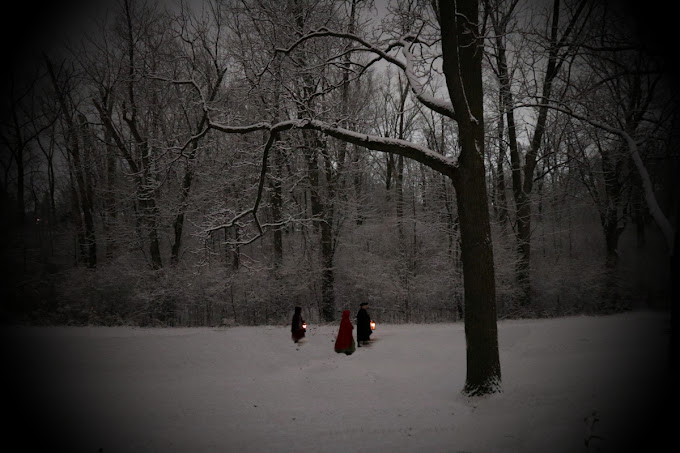 |
| Jennifer and Amy must've thought I was out of my mind when I asked them to come down to the forest of trees in the snow for a photo shoot. I do know, however, they loved the outcome! |
But wintertime is not done yet!
The following is another set of snowy photos. These were taken in late November, many of which I put into a previous blog post, but I thought they would work well here since this is a wintertime at Greenfield Village posting.
Jackie, Charlotte, and I arrived at the Village at opening - 9:30 - to enjoy the last day the Village would be open in daylight hours until springtime. It was just a cold, plain, gray day, and as we were dressed in our 18th century clothing (go figure!), we spent much of our time initially in the area you saw in the photos above - the colonial section of Greenfield Village. However, as we made our way to other parts of the Village, snow began to fall, and soon we were in the midst of a winter wonderland.
I had an idea on taking full advantage of the weather - - - - to head back in the opposite direction...back to where we began when we first arrived------the colonial section!
Why?
Because it was snowing---I had to re-take a few photos!!
Because it was snowing---I had to re-take a few photos!!
Not everyone had a horse, you see, so walking was the mode of travel for most who lived in the 18th century, as long as the snow wasn't too deep. However, I've been dealing with sciatica, and walking has been tough. So as painful as it was, I also walked, for they would not allow me to bring my horse into the Village.
Okay, so I don't actually have a horse...so I walked. But you shoulda seen me hoofing it to the other side of the Village as the snow flew!
Oh! My aching back and legs!
But it was so worth it - - - - - -
But it was so worth it - - - - - -
 | ||
To backtrack back to Daggett there is a sort of short cut along the circular pond where the old steamboat used to be, and that's the route I took. In this picture by Catherine Marie Wrublewski-Kendzior I was really hoofing it - huffin' and puffin' like a 60 year old man! Wait a minute---I AM a 60 year old man! lol That's not too old, I know...but it certainly isn't 20! Especially with sciatica---ouch! Also unbeknownst to me, Lee Cagle, a driver of the Model T's (and quite an amazing photographer), also took a photo of me making my way back to my favorite house. He was taking a break inside the Swiss Chalet when he snapped it:
|
The 18th century saw the tail-end of what is now known as “The Little Ice Age,” a period lasting from the years 1300 to about 1850. It was during this time the world saw much harsher winters than the previous and following centuries, with many well-documented winter storms capable of dropping three feet of snow over a matter of hours. With these intense winters came the need to keep warm in the home.
 |
| We here in lower Michigan are used to having full-blown snowstorms. Not just a few flurries, but actual inches and sometimes even feet of the white stuff, falling as early as October and ending as late as May. And, contrary to popular belief, many of us love the snow and enjoy the winter weather...at least until March! |
 |
| When such a storm occurs, my winter-wear will keep me warm and dry. And those rare times when it occurs while I'm at the Village, I will head directly over to the colonial end, where all my favorite houses of the 18th century are situated near each other, making for a small sort of vignette of 18th century America (with a touch of England for good measure). |
As rare as it is to be in a snow squall while at Greenfield Village, it happened to me twice in late 2021, and both times I was in clothing of the 18th century, and both times are documented in today's posting. Now that's pretty darn awesome!
 |
So I returned to my favorite house; the stark dark gray structure was such a wonderful welcoming sight! And there was Gigi: "I was wondering who that crazy colonial person was out there in the snow taking pictures!" she kidded. "Come on in!" |
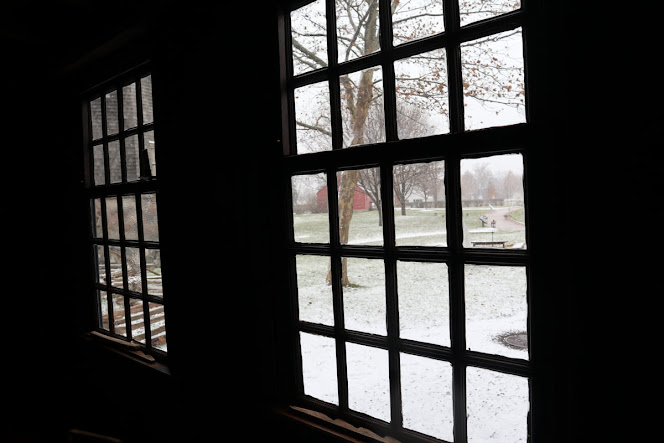 |
Invited into the house once again, the coziness was felt as I glanced out the window into the winter wonderland that lay all around. I don't believe I've ever looked out these windows during the daytime while snow fell. That may not sound like anything to most people, but to me it meant something special - another similar sight that eyes from those who lived 250 years ago had seen, and now I myself was experiencing the very same. Oh, perhaps not this very same scene, but the experience is there. |
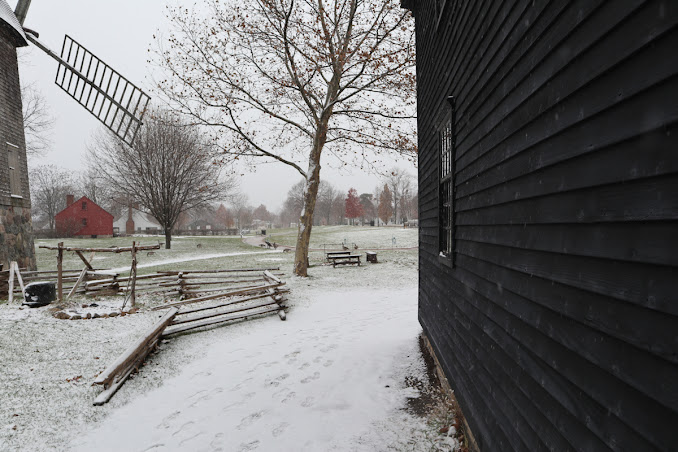 |
| And, along the same lines, stepping out the back kitchen door, one is easily drawn into the world of long ago, for a snippet of the 17th century windmill and the red Plympton house from the early 1700s - both now standing as a much older version of their former selves when the Daggett House was built in the mid-18th century, but looking quite the same. |
 |
| Wintertime in the colonial era brought in discomfort and dread to most in the United States, especially to those living in New England, the mid-west, and the plains areas. For Samuel Daggett and his wife, Anna, winter preparations would occur year 'round. Piles of firewood were cut and stacked in the warmer months for heat in cooler times and for cooking year round. Corncobs were saved for smaller fires, or for an extra touch of flavor in hams and bacon smoked over them. If the fire went out, flint and steel could spark a new one, or a child could scamper to a neighbor and bring home a hot coal in a cook pot or a tray of green bark. |
As I continued trekking along, I took deep breathes to fill my lungs with the fresh winter air. It was invigorating to say the least.
 |
| I had to get moving - my friends Jackie & Charlotte were waiting for me! Photographer Gary Thomas caught me on my quick-step to the McGuffey Cabin. |
 |
| I like the way Gary framed this picture. For a bit the snow really came down hard. It was perfect! |
 |
| From 1780 Pennsylvania we have the McGuffey Cabin, the birthplace of William Holmes McGuffey (1800). I've experienced wintertime in a cabin before (though not this cabin) -What a wonderful experience we had! Click the link below to find out: A Day In The Life: Spending Time In Winter 1771. |
 |
| I love this country lane that actually leads to Firestone Farm, which was originally built in the 1820s but greatly updated in the 1880s ...however, with a little photo-trickery, I modified this photo slightly to have this lane lead to the Daggett House & farm, which is more suitable to not only my clothing, but to this post. I moved past the Loranger Gristmill (actually from the early 1830s, though looking very similar to gristmills 70 years earlier) and the Weaving Shop (built in 1840 but, again, having a strong 18th century look) that now houses historic spinning wheels and looms dating back to the 18th century. Then, as I continued on I passed the heirloom apple orchard that includes such ancient varieties as the Roxbury Russett, Maiden's Blush, the Rambo, and a host of others, all familiar to Samuel Daggett, who actually did have an apple orchard on his property. The land here (with the actual Firestone Farnhouse upon it) is a real working farm with the field work, so the look here is accurate to a colonial-era farm. |
So there you have a couple of winter scenes straight out of the past. The cold does not bother us nearly as you might think, for we are enjoying ourselves in not only what we are doing, but in weather that adds greatly to our experience and the entire look.
However, sadly, after these two visits, Greenfield Village will not be opened again until mid-April. The bleak mid-winter is always a tough part of the year. But I have a few ideas that you may soon be reading about here.
Until next time, see you in time.
Greenfield Village: Autumn 2021 Visits
Greenfield Village: Summer 2021 Visits
Greenfield Village: Spring 2021 Visits
~ ~ ~

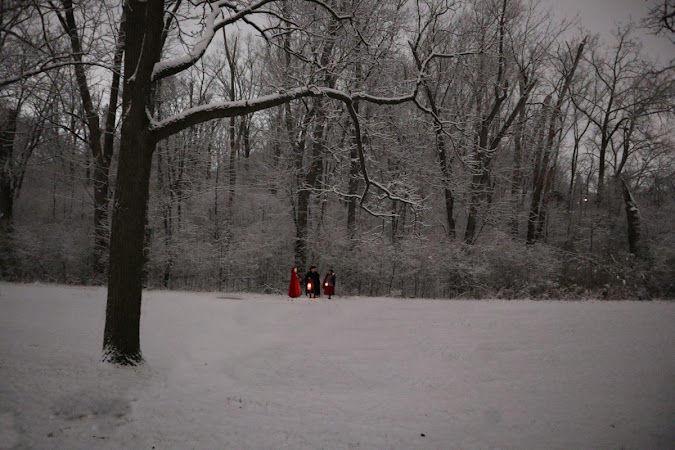






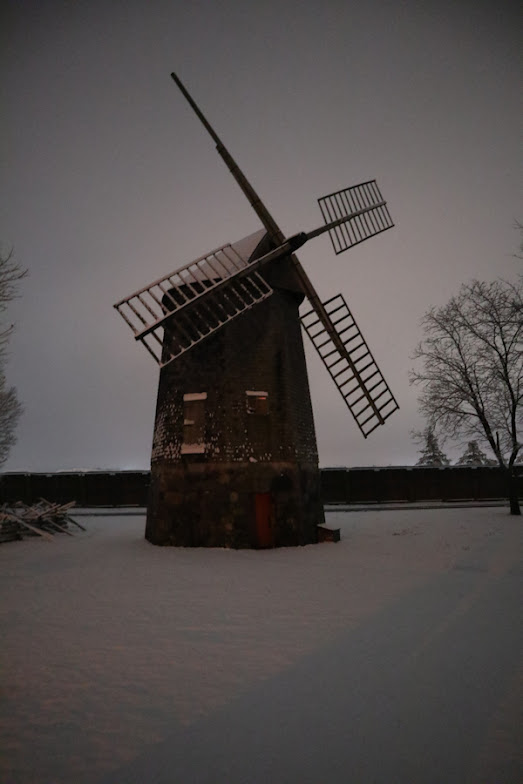
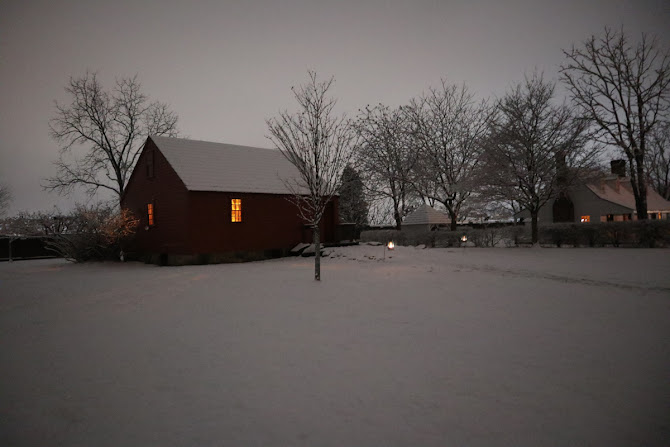




There is something to the feel of a place with certain details such as snow or spring light etc. It's quite the thought to think of who has looked through those window panes and what was seen on the other side.
ReplyDelete